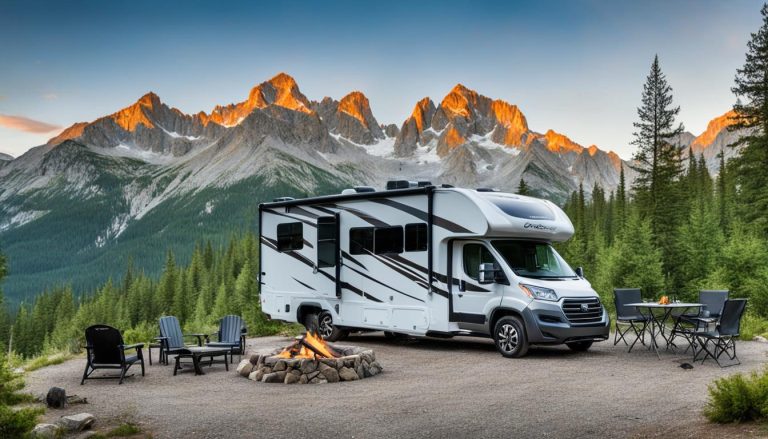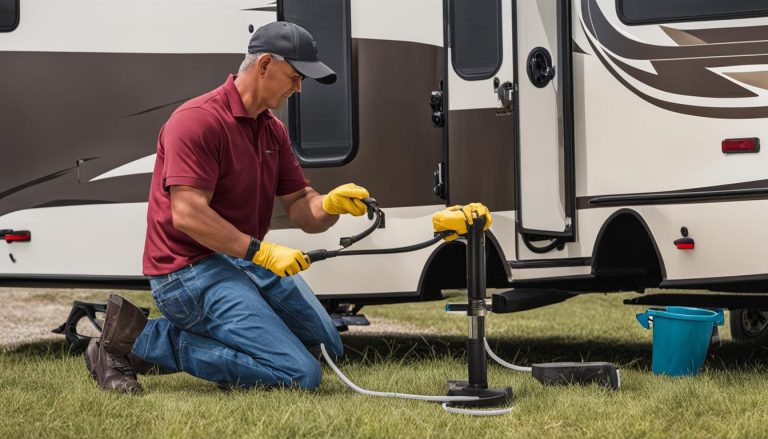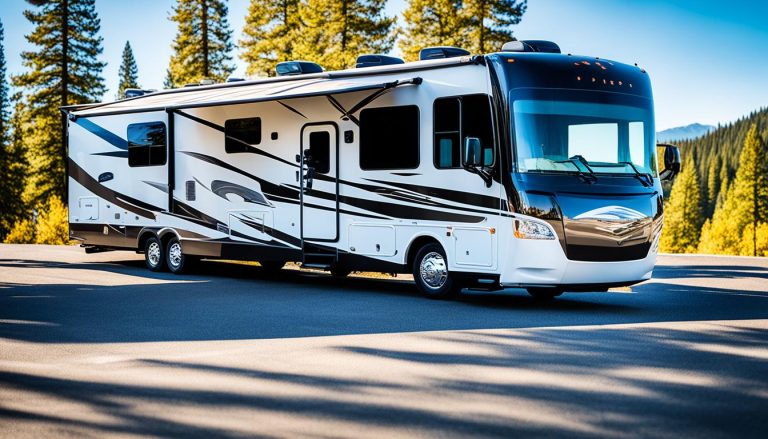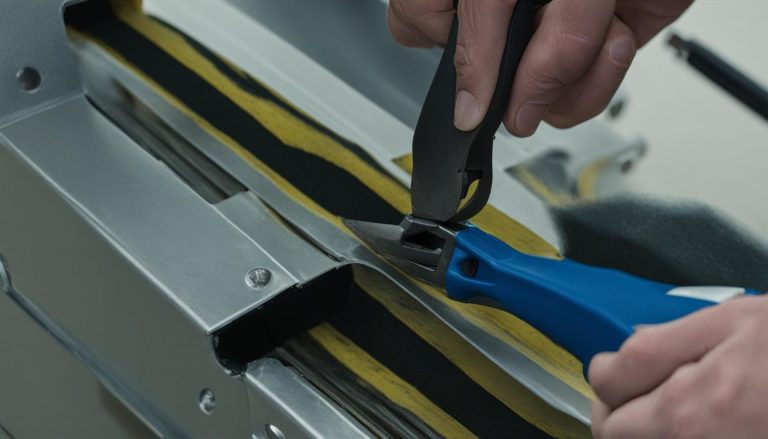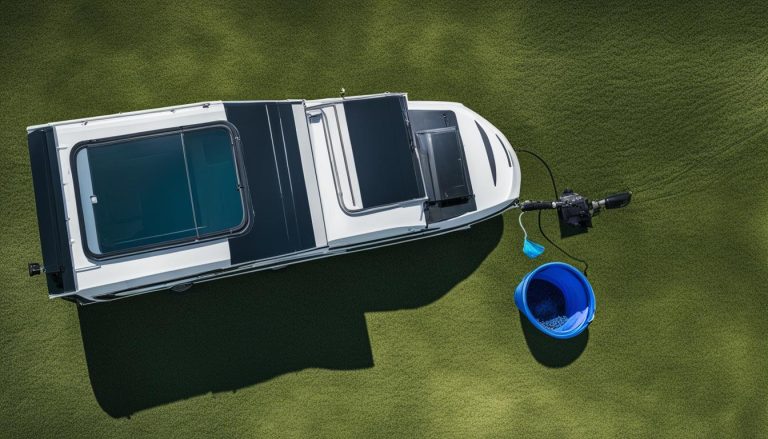RV Awning Fabric Replacement Guide
gorvlifestyle.com and its partners may earn a commission if you purchase a product through one of our links
If your RV awning fabric is worn, torn, or sagging, it’s time for a replacement. This DIY project can save you time and money while ensuring your next adventure is shielded with ease and confidence. In this guide, we’ll take you through the step-by-step process of replacing your RV awning fabric, from securing the head assemblies to enjoying your new fabric. Follow along to learn how to upgrade or replace your fabric and enjoy a renewed shade and privacy for your RV patio area.
Key Takeaways:
- Replacing your RV awning fabric is a simple DIY project that can save you time and money.
- Follow step-by-step instructions to properly replace your RV awning fabric.
- Consider Solera awning fabrics for their durability, heat-welded seams, and heavy-duty materials.
- Electric awning fabric replacement requires additional considerations; consult your owner’s manual.
- Choose the right awning fabric based on durability, color options, and material types.
To keep your RV awning fabric in good condition and prolong its lifespan, follow these tips and maintenance practices:
- Regularly inspect the fabric for signs of wear, tear, or sagging.
- Clean the fabric and awning track regularly to remove dirt, mold, and mildew.
- Avoid leaving the awning extended during strong winds or storms.
- Use fabric protectants or treatments to enhance the fabric’s durability and resistance to fading.
- Store the awning properly when not in use, ensuring it is completely dry and free from debris.
How to Replace RV Awning Fabric
Replacing RV awning fabric might sound like a daunting task, but with a few tools and the help of a friend, it can be a simple DIY project. Follow these steps to replace your RV awning fabric:
- Extend Awning and Secure Head Assemblies: Extend your awning and secure the head assemblies on each side using zip ties.
- Take Roll Tube Off: With the help of a friend, detach the roll tube from the head assembly on both ends and place it on a clean, level surface.
- Unroll the Fabric from the Roll Tube: Remove the end cap of the roll tube and unroll the fabric from the tube.
- Detach Fabric from the Roll Tube: Remove the screws attaching the fabric to the roll tube and separate the fabric from the tube.
- Prep Fabric Track for Installation: Lubricate the fabric track with silicone spray and inspect the new fabric for tears or rips before installing it.
- Roll New Awning Fabric onto the Roll Tube: Feed the polycord through the track and attach the fabric to the polycord on both ends with screws. Then, roll the fabric onto the tube, ensuring it stays tight and flat.
- Reinstall Roll Tube End Cap: Secure the roll tube end cap with screws and widen the awning rail for easier installation, using a flathead screwdriver.
- Test to Ensure the Fabric is Centered: Slide the polycord tube through the railing and reinstall the tube into the head assemblies on each side. Extend and retract the awning a few times to ensure the fabric is centered.
- Reinstall Polycord Screws to the Awning Tube: Screw in the last polycord screws on both sides of the awning tube, using the previous holes for installation.
- Enjoy Your New RV Awning Fabric: Congratulations! You’ve successfully replaced your RV’s awning fabric. Now you can enjoy your renewed shade and privacy.
Replacing your RV awning fabric is a rewarding project that can save you money and ensure a comfortable outdoor experience. By following these steps, you can easily replace your awning fabric and enjoy the benefits of a refreshed RV awning.
Why Choose Solera Awning Fabrics
When it comes to choosing awning fabric for your RV, Solera is an exceptional brand to consider. Solera awning fabrics offer several advantages that set them apart from other brands in the market. With their commitment to quality, durability, and rigorous testing, Solera fabrics provide unmatched performance and reliability for your RV awning.
“Solera fabrics go the extra mile with heat-welded seams, heavy-duty materials, and rigorous testing to ensure they can withstand the wear and tear of the elements.”
The durability of Solera fabric is one of its standout features. The fabrics are designed with heat-welded seams, ensuring superior strength and longevity. This construction technique eliminates the need for stitching, which can weaken over time and lead to fraying or tearing. With Solera fabrics, you can trust that your awning will withstand the rigors of outdoor use and remain in excellent condition for years to come.
Another key advantage of Solera awning fabrics is their use of heavy-duty materials. These fabrics are specifically engineered to withstand harsh weather conditions, including wind, rain, and UV rays. With their high tensile strength and resistance to abrasion, Solera fabrics are built to withstand the elements and provide reliable protection for your RV.
In addition to their durability, Solera fabrics undergo rigorous testing to ensure their performance and quality. The fabrics are subjected to extensive UV exposure, moisture resistance, and colorfastness tests, ensuring that they maintain their integrity and appearance over time. With Solera fabrics, you can have ultimate confidence in the quality of your RV awning.
Explore the wide selection of Solera awning fabrics and find the perfect one for your RV. Whether you prefer vibrant colors or subtle neutrals, Solera offers a variety of options to suit your style and preferences. Upgrade your RV awning with Solera fabric and enjoy the peace of mind that comes with knowing you have chosen a top-quality brand.
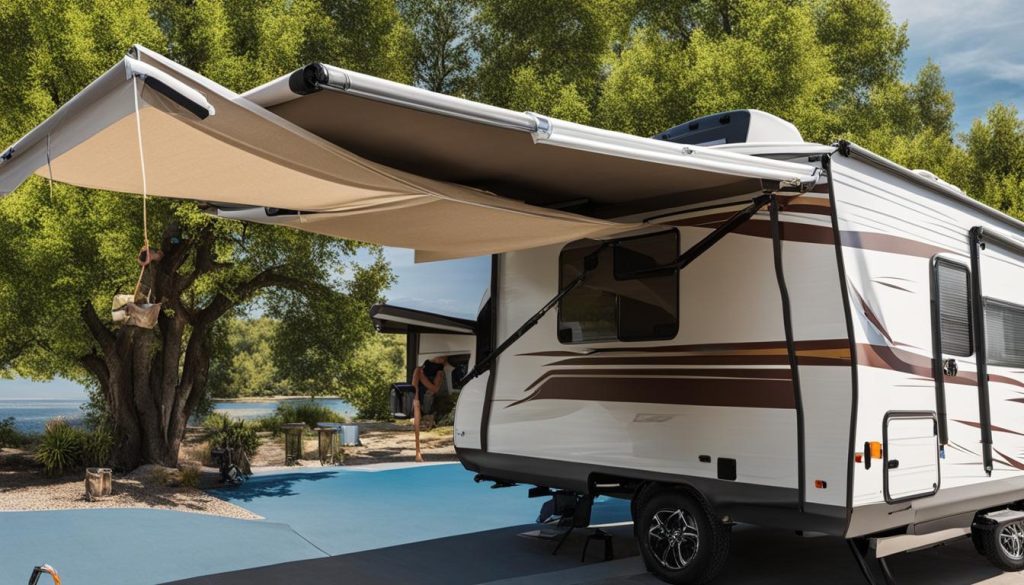
Electric Awning Fabric Replacement
If you have an electric awning, replacing the fabric requires a slightly different process compared to a manual awning. While the basic steps are similar, there are additional considerations to keep in mind. Consult your owner’s manual for specific instructions, but here are the general steps for replacing electric awning fabric:
- Pull Out the Awning: Extend the awning and lock the stabilizing arms in place.
- Lock Springs In Place: Ensure the springs are locked into place by setting the lever in the “roll down” position and inserting a pin or nail into the rear end cap of the awning tube.
- Remove Awning Tube from Awning Arms: Unscrew the bolts to release the awning tube from the awning arms on both ends.
- Unwind the Spring: Use a vice grip and screwdriver to hold the cap in place while unwinding the spring.
- Remove Awning End Cap: Take off the end cap of the roller tube and remove the awning spring.
- Remove Awning Roller from Awning Fabric: Slide the awning roller off of the old awning fabric.
- Remove Awning Arms from RV: Unscrew the bolts to remove the top bracket from the awning arm and pull off the arm.
- Removing Old Awning Fabric: Slide out the old awning fabric by removing screws and applying a bit of muscle.
- Scrub Out Dirt and Grime: Clean the awning track and roller tube from dirt and grime.
- Installing New Awning Fabric: Slide the new fabric into the track, re-install the awning arms, and secure the roller tube with the new fabric.
- Wind Up the Awning Spring: Wind up the awning spring using the lever in the “roll down” position and secure it with set screws.
- Attach Roller to Arms: Re-attach the awning arms to the roller tube.
- Test Out Your New Awning and Secure in Place: Remove the pin from the end of the awning to test its functionality and secure the fabric with set screws.
Replacing the fabric on an electric awning may require additional steps depending on the specific model and design. Be sure to consult your owner’s manual for precise instructions tailored to your electric awning. With proper care and maintenance, your electric awning fabric replacement will ensure many more enjoyable outings with your RV.

Choosing the Right Awning Fabric
When it comes to selecting new awning fabric for your RV, there are several factors to consider. Choosing the right fabric will ensure durability, enhance the aesthetic appeal, and protect your RV from the elements. Take a look at these key considerations to help you make an informed decision:
Durability
One important factor to consider is the fabric’s durability. Vinyl is a popular and budget-friendly option for RV awning fabric. It is resistant to moisture, UV rays, and mildew. However, if you’re looking for enhanced durability and better resistance to fading, acrylic fabric might be a better choice. Acrylic fabric is known for its strength and longevity, making it ideal for long-term RV use.
Color Options
Another consideration is the range of color options available. Vinyl fabrics generally offer a limited selection of colors. On the other hand, acrylic fabrics provide a wider range of colors to choose from, allowing you to find the perfect shade that matches your RV’s exterior and personal style. This flexibility in color options can add a touch of personality to your RV’s outdoor space.
Material Types
When it comes to material types, Sunbrella stands out as a high-quality option. Sunbrella fabrics are known for their exceptional durability, fade resistance, and ability to withstand harsh weather conditions. Whether you prefer vibrant colors or neutral tones, Sunbrella offers an extensive range of fabric choices to suit your preferences.
Consult with a reputable supplier or manufacturer to explore the various awning fabric options available. They can provide valuable insights and recommendations based on your specific needs and preferences. By choosing the right awning fabric, you can enhance both the aesthetics and functionality of your RV’s outdoor living space.
Tips and Maintenance for RV Awning Fabric
To keep your RV awning fabric in top condition and extend its lifespan, it’s important to follow these essential tips and maintenance practices:
1. Regular Inspection: Periodically inspect your awning fabric for any signs of wear, tear, or sagging. Detecting and addressing these issues early on can prevent further damage and potentially save you from having to replace the entire fabric.
2. Regular Cleaning: Keep your awning fabric and the awning track free from dirt, mold, and mildew. Clean the fabric using a mild detergent or dedicated awning cleaner, following the manufacturer’s instructions. Regular cleaning helps maintain the fabric’s appearance and prevents the build-up of damaging substances.
3. Weather Awareness: During strong winds or storms, it’s important to retract your awning to protect it from potential damage. Leaving the awning extended in adverse weather conditions can result in fabric tears or even the complete destruction of the awning mechanism. Stay attentive to weather forecasts and retract your awning accordingly.
4. Fabric Protection: Enhance the durability and longevity of your awning fabric by using fabric protectants or treatments. These products create a protective barrier against UV rays, fading, and other environmental factors that can degrade the fabric over time. Follow the instructions on the product label for the best results.
5. Proper Storage: When not in use, make sure to store your awning properly. Remove any debris or leaves from the fabric and ensure it is completely dry before rolling it up. Store the awning in a clean and dry location to prevent mold growth and maintain its overall condition.
6. Follow Manufacturer’s Instructions: Every RV awning fabric is unique, so it’s crucial to follow the specific care recommendations provided by the manufacturer. This includes any guidelines for cleaning, maintenance, and repairs. By adhering to these instructions, you can ensure optimal performance and maximize the lifespan of your awning fabric.
By implementing these tips and maintaining proper care for your RV awning fabric, you can enjoy its shade and protection for many memorable outdoor adventures to come.
FAQ
How can I replace my RV awning fabric?
To replace your RV awning fabric, follow these steps: extend and secure the head assemblies, take the roll tube off, unroll and detach the fabric from the roll tube, prep the fabric track for installation, roll the new fabric onto the roll tube, reinstall the roll tube end cap, test to ensure the fabric is centered, reinstall polycord screws to the awning tube, and finally, enjoy your new RV awning fabric.
Why should I choose Solera awning fabrics for my RV?
Solera awning fabrics are a great choice for your RV because they feature heat-welded seams, heavy-duty materials, and undergo rigorous testing to ensure durability. With Solera, you can have confidence in the quality and longevity of your awning fabric.
How do I replace the fabric on an electric RV awning?
To replace the fabric on an electric RV awning, follow these steps: pull out the awning, lock the springs in place, remove the awning tube from the awning arms, unwind the spring, remove the awning end cap, remove the awning roller from the fabric, remove the awning arms from the RV, remove the old fabric, clean the track and roller tube, install the new fabric, wind up the awning spring, attach the roller to the arms, test the awning, and secure the fabric in place.
How do I choose the right awning fabric for my RV?
Consider factors such as durability, color options, and material types when choosing awning fabric for your RV. Vinyl is the least expensive option, while acrylic fabric offers greater durability and resistance to fading. Sunbrella is a high-quality option known for its longevity and wide range of colors. Consult with a reputable supplier or manufacturer to find the best fabric for your needs.
What are some tips for maintaining RV awning fabric?
To maintain your RV awning fabric, regularly inspect it for signs of wear or tear, clean the fabric and track regularly to remove dirt and mold, avoid leaving the awning extended in strong winds or storms, use fabric protectants to enhance durability and resistance to fading, and store the awning properly when not in use, ensuring it is dry and free from debris. Follow the manufacturer’s care instructions for specific recommendations.

